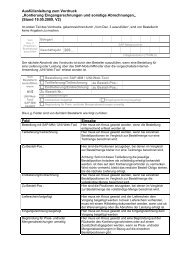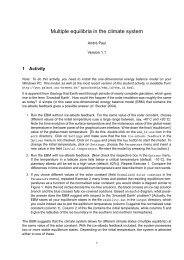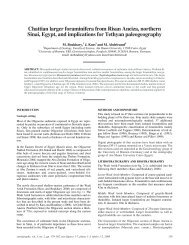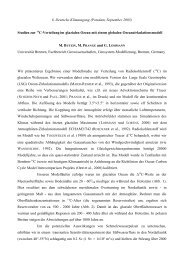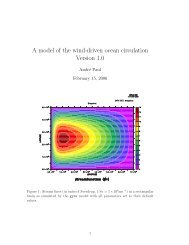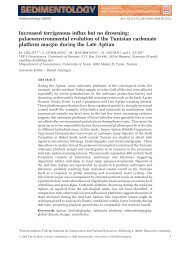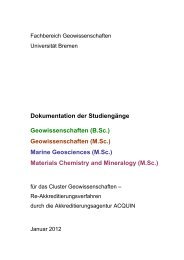Forschung im HLRN-Verbund 2011
Forschung im HLRN-Verbund 2011
Forschung im HLRN-Verbund 2011
- Keine Tags gefunden...
Sie wollen auch ein ePaper? Erhöhen Sie die Reichweite Ihrer Titel.
YUMPU macht aus Druck-PDFs automatisch weboptimierte ePaper, die Google liebt.
174Cosmic Magnetic FieldsMagnetic fields in galaxy clustersC. Lämmerzahl, M. Brueggen, Universität BremenKurzgefasst• In this project we s<strong>im</strong>ulate cosmic magnetic fieldsin galaxy clusters which are the largest structuresin the universe.• Cosmic magnetic fields can be inferred from radioobservations of synchrotron radiation.• An innovative European radio telescope will yieldunprecedented insights into cosmic magneticfields.• By comparing s<strong>im</strong>ulations performed at the<strong>HLRN</strong> with observation we can probe plasmaphysics under conditions unattainable on Earth.For quite a while, astronomers have known that thegas between the stars of a galaxy as well as thecosmic medium between galaxies is magnetized,generating giant magnetic fields that stretch overseveral millions of light years. However, very littleis known about their origin and the <strong>im</strong>pact theyhave on the development of galaxies. Very oftengalaxies come in groups of hundreds to thousandsof galaxies, and these associations are called galaxyclusters. Inside a cluster the space betweengalaxies is filled with very hot and dilute gas. Observationswith radio telescopes have shown thatthis gas is magnetized and that the magnetic fieldis roughly a 100.000th of the Earth’s magnetic field(at the surface).The key to the analysis of these magnetic fieldsin outer space is the so-called synchrotron radiationof electrons, which is generated by theelectrons’ orbital acceleration at near light-speedthrough these magnetic fields. The electrons werecharged with the energy necessary for such radiationthrough shock waves of cosmic catastropheslike supernova explosions, collisions of galaxies oreven galaxy clusters. The radiation pattern of theelectrons, which reflects the stars’ or galaxies’ history,thus becomes a marker for surveying and interpretingthe magnetic fields from Earth, whichwould otherwise not be possible.Central to the effective and sensitive detection ofthe cosmic synchrotron radiation is the newly constructeddigital telescope LOFAR (acronym for LowFrequency ARray). While classical radio telescopescollect cosmic radiation with motor-operateddish-like antennae, which scan different areas ofspace with computer-controlled movements, LO-FAR does not require any moving parts. It consistsof a set of s<strong>im</strong>ple, small radio antennae fixed to theground that are spread all over Europe. One antennastation, constructed by Jacobs University, ispositioned close to the German city of Jülich.All data coming in from the different antenna locationsare correlated by one of the world’s fastestsupercomputers located in Groningen (The Netherlands).This way, the array of antennae acts likea giant radio-telescope with an equivalent dish-sizeof several hundred kilometres in diameter, whichnot only provides the telescope with a so far unparalleledsensitivity. To analyse these observations,astronomers need to model cosmic magneticfields.Even though the magnetic field in the space betweengalaxies is so weak, it has a profound <strong>im</strong>pacton the dynamics of the gas and thus also on the livesof the galaxies. The reason for this is that heatin the gas is transported almost exclusively alongmagnetic field lines. Hence, the shape of the magneticfield is crucial for the temperature distributioninside a galaxy cluster. The regulation of thetemperature inside this intergalactic gas is <strong>im</strong>portantfor its cooling and condensation onto the galaxies.In this way, the rate at which galaxies growby accumulating gas from their environment is controlledby the magnetic fields around them. In supercomputers<strong>im</strong>ulations performed at the <strong>HLRN</strong>,astronomers from Bremen s<strong>im</strong>ulate these processes.The direct comparison with radio observationsmakes clusters of galaxies unique laboratories forplasmas physics under conditions that cannot beobserved anywhere else. For such dilute plasmaswith particle densities of less than 0.1 particles percube cent<strong>im</strong>etres and temperatures of millions ofKelvin many fundamental properties are completelyunknown. Astronomical observations of objectsthat are millions of light years away in combinationwith supercomputer s<strong>im</strong>ulations, thus lead to insightsinto the microphysics of plasmas. For furtherreading see, e.g., [1].Mehr zum Thema1. Ruszkowski, M., Lee, D., Bruggen, M., Parrish,I., & Oh, S. P. 2010, arXiv:1010.2277FörderungBMBF <strong>Verbund</strong>projekt D-LOFARPhysik



